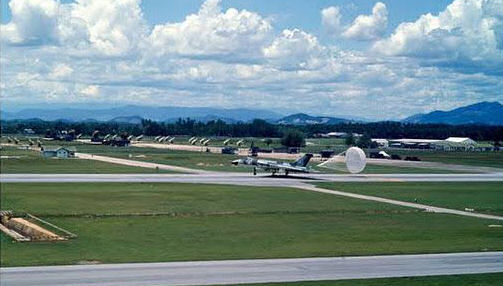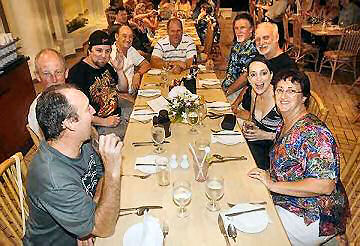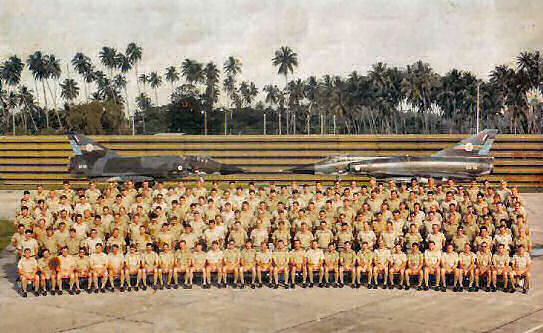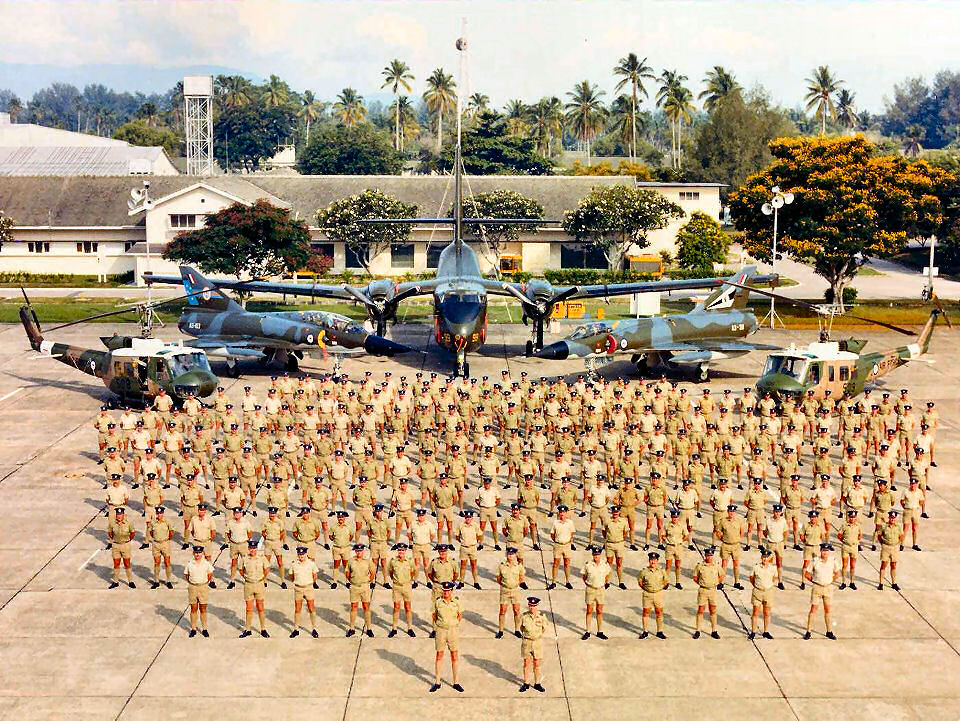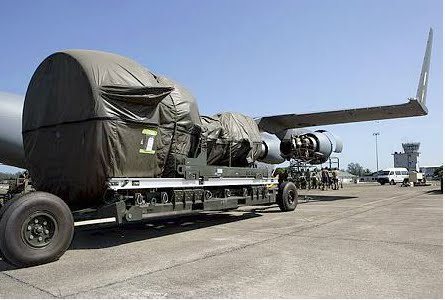|
Radschool Association Magazine - Vol 38 Page 10 |
|
Privacy Policy | Editorial Policy | Profit Policy | Join the Association | List of Members | Contact us | Index | Links |
|
|
|
Butterworth revisited.
In 1950, the British Government made a formal request to the Australian Government, then led by PM Bob Menzies, for Australia to provide a military presence in Malaysia to help combat the increase in build-up of Communist Troops. The Aust Gov’t turned to the RAAF as unlike the people in the regular Army, whose (then) terms of enlistment confined their employment to Australia (poor petals), the RAAF could be sent overseas as and when required. Initially the RAAF hoped to locate only the supporting units permanently to Butterworth, with the flying squadrons rotating from Australia every three months. That was the cheapest option, reducing by about two-thirds the need for family removals, married quarters, medical services and schooling. As Malaya was an 'operational' zone, albeit a fairly benign one, there were also perceived advantages in keeping families out of the area. However, Defence Minister Sir Philip McBride rejected the Air Force's proposal and it was decided that the RAAF would base three operational squadrons permanently in Malaya.
|
|
|
|
In the interests of Australia's longer term national security, keeping the United Kingdom involved in Southeast Asia was considered far more important than worrying about the costs associated with developing Butterworth and paying for several hundred RAAF dependants to live there.
Cabinet decided that the Canberra Squadron should deploy permanently to Butterworth in July 1958 and the Sabres would follow between November 1958 and February 1959. When the Canberras arrived, the Lincolns of No. 1 Squadron returned to Amberley after eight years in Singapore.
Butterworth airfield is located near the township of Butterworth (Click the pic above) which is opposite the island of Penang in Malaysia. The RAF built the airfield and moved in, in 1941, but lost it soon after, then reclaimed it after the defeat of Japan in 1945. The base then played a major part in the defeat of the Communist terrorists during the Malayan Emergency (1948 to 1960). Following the Independence of Malaya, the RAF continued to use the base, sharing it with the RAAF. In 1955 a new north- south runway was built by an RAAF Airfield Construction Squadron.
|
|
The Law of Mechanical Repair - After your hands become coated with grease, your nose will begin to itch and you'll have to pee.
|
|
In 1957, the RAF passed ownership of the airfield to the RAAF and it was renamed RAAF Station Butterworth and became the home to many RAAF personnel and their families. Although they had passed ownership over to the RAAF, the RAF maintained a considerable presence at the base, their 33 Sqn provided ground to air defence with Bloodhound missiles (below) which went into Butterworth in 1965 and stayed until 1969 when the Sqn was disbanded. They also kept a Sqn of Hawker Sidley Hunters as a ground attack aircraft and the RAF Vulcans and Canberras were kept on to provide bombing support. They also had a chopper presence to provide SAR support.
In October 2008, the RAAF handed ownership of the airfield over to the Royal Malaysian Air Force but continues to maintain a presence at the airfield as part of Australia’s commitment to the Five Power Defence Arrangement (United Kingdom, Australia, New Zealand, Malaysia and Singapore).
|
|
The Boatie was officially the "RAAF Butterworth Yacht Club", and in days of old was part of the RAAF establishment. It had some small boats and provided the marine SAR for the RAAF and was also the 'hub' for single men at Butterworth. It is now part of the RMAF complex.
Click HERE to see some video of the Boaty of old - you might just recognize someone.....It is a very large file and will take a while to download.
|
|
|
|
|
|
|
|
|
|
The Law of Gravity - Any tool, nut, bolt, screw, when dropped, will roll to the least accessible place in the universe.
|
|
Sabres on the Flight Line at Butterworth, Malaysia, 1966. (Penang Island is in the background across the strait.)
|
|
|
|
|
|
|
|
|
|
During the 1960s four Australian flying squadrons were based at Butterworth as part of the Far East Strategic Reserve (FESR).
The largest unit was No. 78 Wing, which comprised the Sabre-equipped No. 3 Squadron and No. 77 Squadron. The other flying units were No. 2 Squadron, which operated Canberra bombers and a small number of Dakota transports as well as the UH-1 Iroquois equipped No. 5 Squadron. 78 Wing and 2 Squadron had been based at Butterworth since 1958 and No. 5 Squadron arrived in 1964 in response to one of the Malaysian Government's requests for assistance. |
|
|
|
|
|
|
|
Known by the polite British euphemism of 'emergency', the armed struggle in Malaya from 1948 to 1960 was in fact a war. It was termed an “Emergency” purely for financial and political reasons as insurance policies commonly in force at the time became void in the event of a civil 'war' but remained valid during a civil 'emergency'.
The use of the title 'emergency' also gave a clue to another distinctive aspect of the conflict. Following his appointment in September 1948 as high commissioner of the Federation of Malaya - in effect, as the country's ruler - the British diplomat Sir Henry Gurney decided the armed forces were not going to control the war.
Because the conflict was motivated by ideological differences, Gurney believed British strategy would have to emphasise 'armed support for a political war, not political support for an army war'. The armed forces' role would be to help the government restore law and order, an important distinction from the more common role of defeating the enemy militarily.
|
|
The Variation Law - If you change lines (or traffic lanes), the one you were in will always move faster than the one you are in now.
|
|
The Swimming pool on the base, 1966.
With Butterworth situated a bare 5 degrees north of the equator, the climate ranged from hot with lots of humidity to damn hot with lots more humidity, so the base pool was constantly in demand and was always kept spick and span.
|
|
|
|
|
|
Today, unfortunately, it is not quite as good as it was and it would be a very unwise parent who allowed his/her child to cool off in the tranquil green waters, though a couple of million litres of chlorine and two truckloads of DE would probably fix it in no time.
|
|
|
|
|
|
|
|
In 1958, No 2 Squadron moved to Butterworth.
Its arrival was too late to participate in the Malayan Emergency, by this time the communist insurgency was all over, but it provided security during the 1960's, when tensions with Indonesia and the newly-independent Malaysia resulted in a period of "Confrontation" between Commonwealth and Indonesian forces.
|
|
|
|
|
|
|
|
Aerial photos showing some of the hangars, workshops and hard standings and below, with the two 220 ft masts supporting the non-direction beacon (NDB) in the distance. |
|
|
|
|
|
|
|
Murphy's Law of Lockers - If there are only 2 people in a locker room, they will always have adjacent lockers.
|
|
There were a number of NDB’s around the Indian Ocean area which had been installed and which were maintained by the RAF. Normally, each major airport had one.
These were used as important navigational aids by aircraft and shipping. Each beacon transmitted its own distinctive signal 24 hours a day, seven days a week, 365 days a year. The transmitted non-directional signal was superimposed with a Morse code identifier which could be received by an Automatic Direction Finder (ADF) on board an aircraft or ship thus allowing it to calculate its position when travelling across the vast open ocean.
Although not all that accurate, they were a very useful aid back in the 1960’s. A pilot or ship’s captain would tune into one (log on hadn’t been invented yet) and this would give him/her a bearing from the NDB to his aircraft/ship. As the pilot/captain knew the exact position of the NDB, he could draw a line on his map away from the NDB on the heading shown on his ADF and he then knew he was somewhere on that line. Although handy to know, that was completely useless as he/she could be 50 miles away or 150 miles away from the beacon. So, what he/she would then do is tune into another NDB some distance away from the first and repeat the procedure. He/she would then have two lines which would cross somewhere on his map – and where they crossed was where he/she was.
Normally the pilot/captain would repeat the procedure 3 times, using 3 different NDB’s. This would usually result in a small triangle where the lines crossed, (this was called triangulating your position). It was then anyone’s guess as to where in that triangle he/she was exactly. On the unslaved instrument at left the N indicates the nose of the aircraft and shows the NDB is 160 degrees off to the right of the aircraft. An unslaved ‘card’ always has the N at the top, slaved cards incorporate the magnetic compass into the instrument so the card revolves and always shows the aircraft’s heading. The knob at the bottom left on the instrument can be used to change the unslaved card to indicate the aircraft’s heading. You can see more on this HERE. |
|
NDB’s transmitted on a low frequency, 200 kc/s – 425 kc/s (Khz hadn’t been invented then either) but the equipment in the aircraft/ship would usually receive right up to 1603 kc/s which meant the pilot/captain could also tune into any broadcast radio station within range – which they normally did. Listening to music on the ADF was better than listening to 3 letters being transmitted in Morse or a voice rattling off the local weather conditions.
Pilots would tune into
the local NDB when they were about 30-50 miles away as gradually the
Morse indicator was replaced with a voice indicating the location of
the NDB and this would also broadcast the local weather conditions
current at the time (this was called ATIS – automatic terminal
information service). The transmitted signal could also be used as a
NDB’s and ADF’s are a bit like horse-shoes, very handy in their day – they still work but are not quite as in demand as they once were and have been more or less superseded today.
Right/below, the old HF transmitters’ antenna farm, another piece of equipment that is rapidly becoming obsolete. In the 60’s – 70’s, before the satellite and/or microwave era, HF was the only way to communicate over long distances. HF is generally referred to as being the frequency range from 2Mhz to 30Mhz.
With output power and atmospherics being equal,
usually the frequency used determines the range of the transmission,
a 3Mhz signal can usually be
Single side band (SSB) transmission was invented back in 1915 but it wasn’t until WW2 that it was commonly used and this allowed the signal to travel much further. (See Frank Alley’s article on SSB HERE).
HF is upset by atmospherics, in bad weather and during severe sun spot activity it is next to useless. Duplex VHF, satellites and microwave links have virtually made HF comms between aircraft and ground a thing of the past. It is still used by amateur radio people who relish in getting their signal as far as possible.
|
|
The Law of Logical Argument - Anything is possible provided you don't know what you are talking about.
|
|
The Vulcans.
During the late 1950s
and 1960s, RAF Bomber Command had their AVRO Vulcan aircraft
stationed at Butterworth, on detachment from the UK. These were
there to combat the Malaysian Communist problem and then for the
later Indonesian Confrontation.
In the final years of service, six Vulcans were converted to in-flight tankers.
It carried a crew of 5, pilot, co-pilot, AEO and 2 Navigators. It had a max speed of 530 kts, a range of 4,200 klms, and a service ceiling of 55,000 ft.
The School. With all the families stationed at Butterworth it was evident that there were also a lot of kids. Postings usually lasted for 2-3 years so it was important that the kids received an education on par with what they would receive if still in Australia. The RAF provided schooling up until 1960, which also looked after the Ozzy kids, but when the RAF pulled out in 1960, the schooling was closed. There was now an urgent need for a dedicated RAAF school. Initially, schooling was provided on the base with the assistance of wives of servicemen who were ex-school teachers.
An Interim School
was established in August 1958, in a building formerly occupied by
the Mayor of Georgetown but was, at the time, vacant. The School
catered for infants and primary children, with secondary pupils
working by correspondence. By September 1958, enr
In October 1958 the Department of Air established a more permanent school with teaching staff selected from the Departments of Education of New South Wales and Victoria. Schooling was provided to end of Year 8, with children past Year 8 undertaking correspondence classes. There were 219 primary children at the school by 1962.
With enrolments consistently increasing it was apparent that a new school was needed. The go ahead was given and in March 1962, a new school was built at a cost of approximately $90,000. This new school, which consisted of three main building blocks, an assembly hall and a hut next to the hall for infants, was originally built to cater for a population of approximately 550 students, however this proved to be a grossly inadequate estimate as time went by. Numbers arriving at the school consistently increased over the years and the school needed frequent extensions and upgrades. In September 1965 a new block was built consisting of 4 classrooms and by 1966 student numbers had grown to around 750. Initially, temporary extensions were made to accommodate the extra students but permanent accommodation was approved for 850 students shortly after.
By 1971 student numbers had increased to over 1000 and reached a high of 1100 in 1977. Another block was built as more students were expected and again in 1977, more extensions were made to accommodate more primary students. The school had a 26 year life span, and closed in 1988. The buildings were handed over to the Royal Malaysian Air Force (RMAF) and are used as a training facility and admin centre. It is estimated that a total of 10,000 kids received their education at the RAAF School in Penang.
Ex-students of the school keep in touch with each other and hold reunions – they have a web site which you can access HERE.
The Mirages. Early in 1967, 3 Sqn was disbanded and the personnel and Sabres returned to Australia, but as Australia’s involvement in the Vietnam War intensified, 3 Sqn was reformed at Williamtown (later in 1967) and equipped with the Mirage. The aircraft were painted with a camouflage design and sent back to Butterworth which had recently had its runway resealed to carry heavy aircraft. 77 Sqn also returned to Australia in 1969, and were replaced by 75 Sqn which also had the Mirage. Numbers 3 and 75 Squadrons then operated the Mirage from Butterworth.
The Mirage was an aircraft that required a lot of maintenance and 478 Maintenance Squadron was responsible for major servicing as well as looking after the Caribous of Transport Support Flight and the Iroquois of 9 Sqn both of which had returned from Vietnam.
|
|
|
|
|
|
The Mirages returned to Australia in 1986.
These days, the RAAF only has a minor presence at Butterworth, but regularly stages aircraft through there.
|
|
The Law of the Theatre and Football ground - At any event, the people whose seats are furthest from the aisle, always arrive last. They are the ones who will leave their seats several times to go for food, beer or the toilet and who leave early before the end of the performance or the game is over. The folks in the aisle seats come early, never move once, have long gangly legs or big bellies and stay to the bitter end of the performance. The aisle people also are very surly folk. |
|
Engine Change. In June 2009, a C-17 of 36 Sqn landed at Butterworth with a bung engine. As the RAAF had taken delivery of their first C-17 on the 28 November 2006, the normally reliable engines (Pratt and Whitney F117 turbofans) which were developed exclusively for the C-17, were still reasonably ‘new’ and had performed faultlessly – so it came as a bit of a shock to 36 Sqn that they had an engine change on their hands and to make matters worse, the change would have to be done away from home.
Each engine weighs
6,800kg, so specialised GSE is required to handle one. The sumpies
at
A Boeing rep also went for the ride as he wanted to know why the engine failed.
By the end of the first day, the bung engine was off the wing. Day two saw the replacement engine mounted and, on the third day, the aircraft had performed its engine power checks and the aircraft was good to come home.
4 RAAF Hospital. In 1964 No 4 RAAF Hospital opened at Butterworth and was an important staging respite for treating wounded servicemen from Vietnam before they were repatriated back to Australia. 4 RAAF remained at Butterworth until it was disbanded in 1987.
|
|
|
|
Brown's Law of Physical Appearance - If the clothes fit, they're ugly.
|
|
|
|
Back Go to page: 1 2 3 4 5 6 7 8 9 10 11 12 13 14 15 16 17 18 19 20 Forward
|

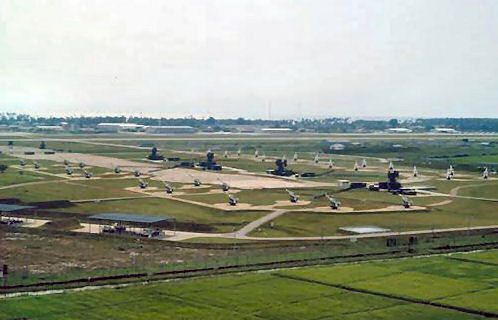
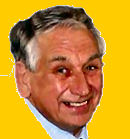 Richard
Harcourt, who unfortunately recently lost his wife to cancer, was a
radio bod with the Pommie Air Force. He spent a lot of time in
Butterworth and judging from the number of photos he has taken, he
must have walked everywhere with an AVO in one hand and a camera in
the other. His photos turn up all over the place, on web sites
everywhere. He has sent us some of the following which will, we’re
sure, bring back a lot of fond memories to a lot of good people.
Richard
Harcourt, who unfortunately recently lost his wife to cancer, was a
radio bod with the Pommie Air Force. He spent a lot of time in
Butterworth and judging from the number of photos he has taken, he
must have walked everywhere with an AVO in one hand and a camera in
the other. His photos turn up all over the place, on web sites
everywhere. He has sent us some of the following which will, we’re
sure, bring back a lot of fond memories to a lot of good people.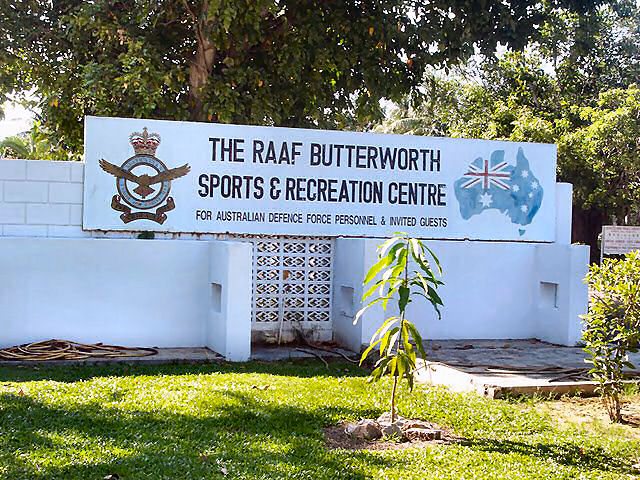
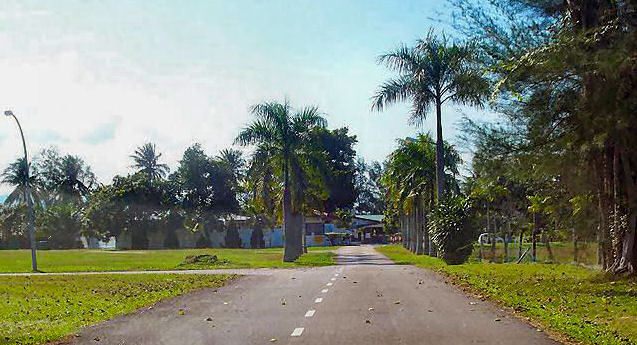
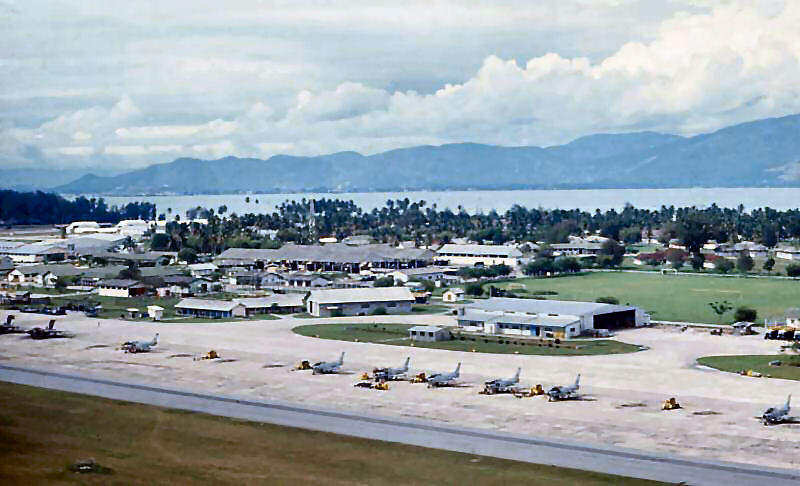
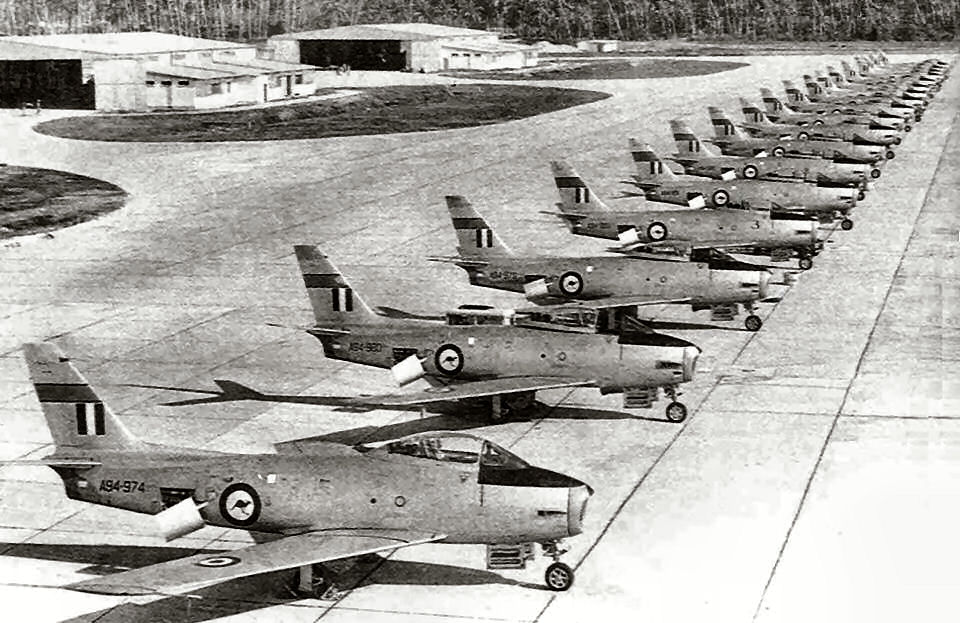
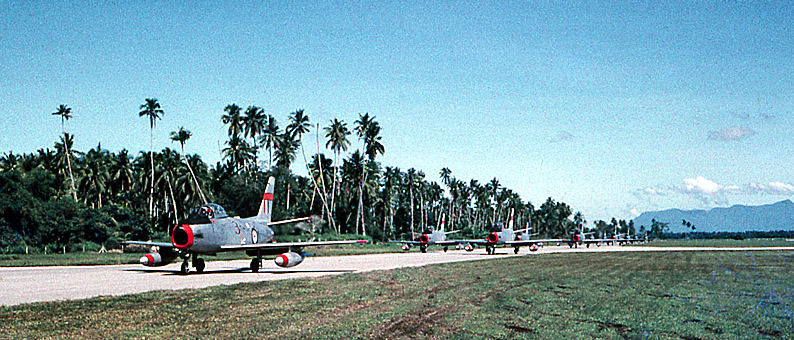
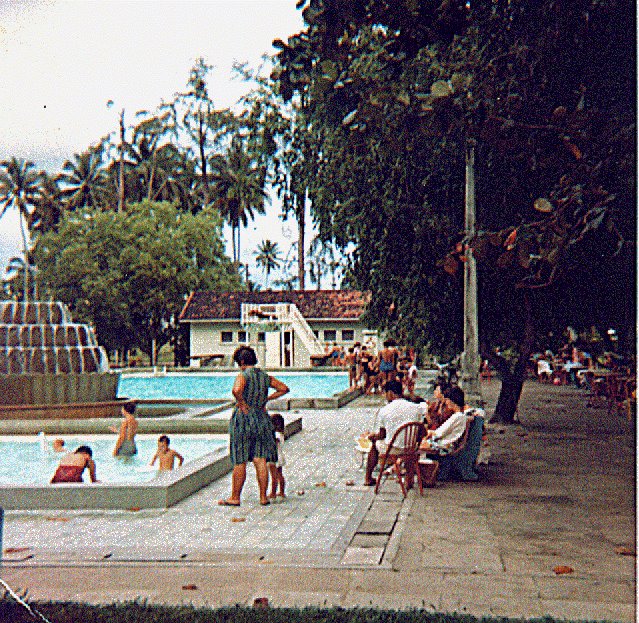
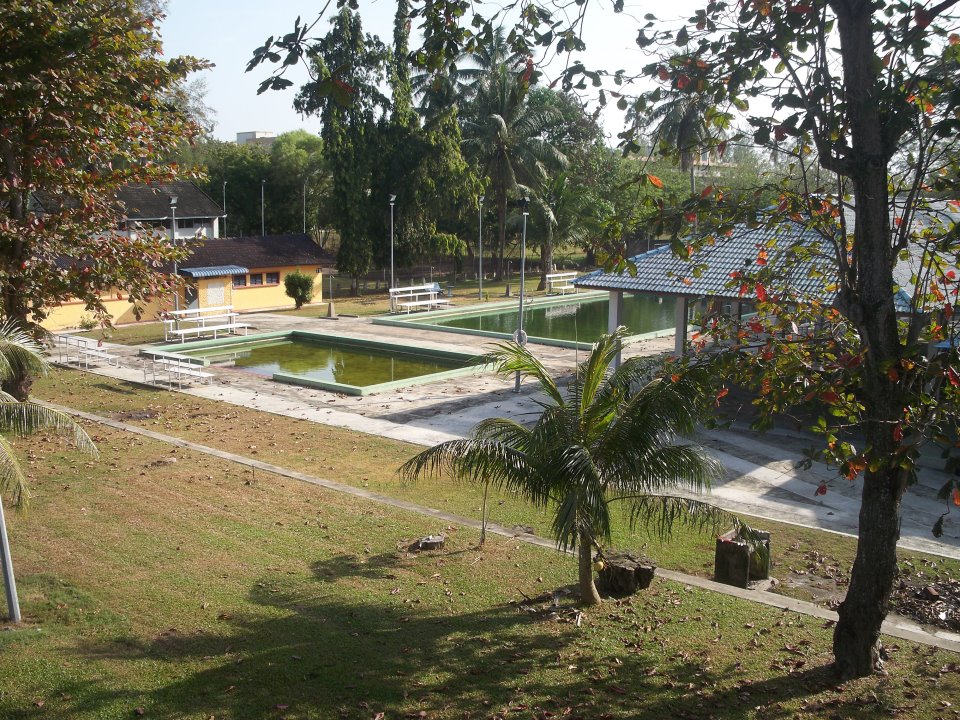

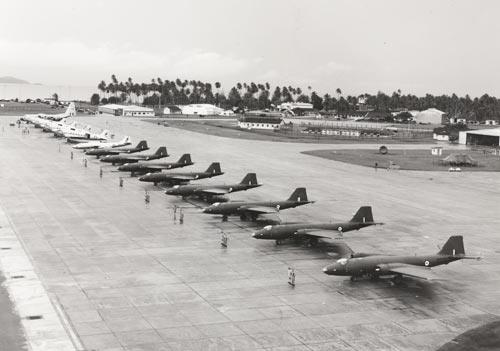 2
Squadron.
2
Squadron.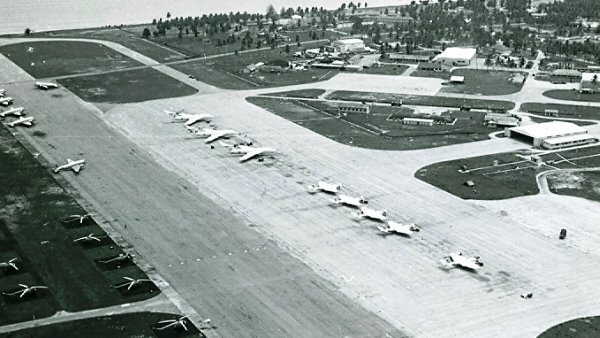
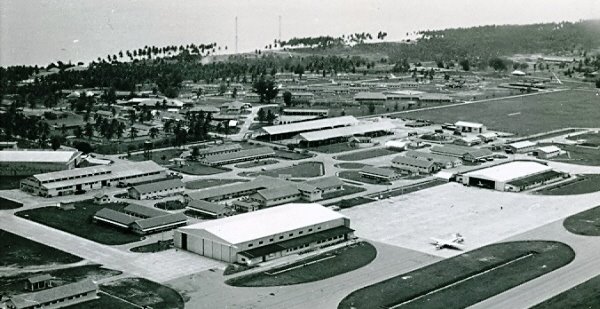
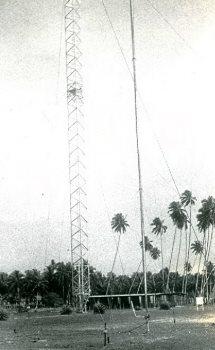

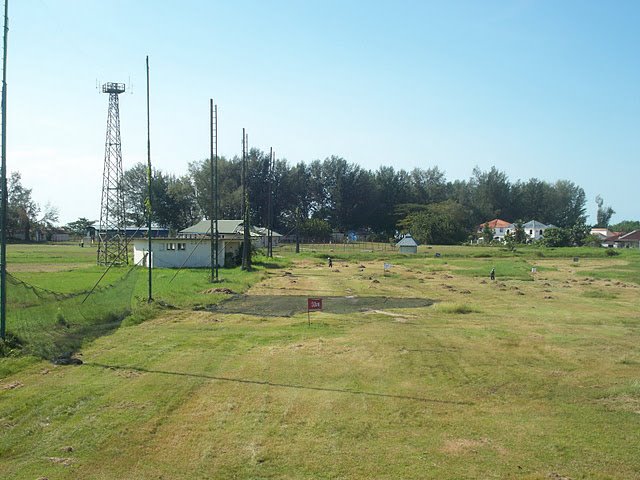 non-precision approach aid at airports not equipped with an ILS, ie,
if the weather was crook you could do what was called an NDB
approach. This was common place back in the 60’s though it is
probably not taught today and many younger pilots would not have a
clue how to accomplish one.
non-precision approach aid at airports not equipped with an ILS, ie,
if the weather was crook you could do what was called an NDB
approach. This was common place back in the 60’s though it is
probably not taught today and many younger pilots would not have a
clue how to accomplish one.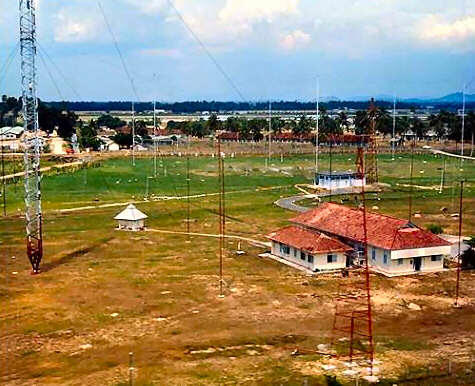 heard 150 klms away during the day and
250 klms at night. 5Mhz will travel about 500 klms during the day
and 800 klms at night and 13Mhz will travel 3300 klms during the day
and 4000klms at night and that is usually the limit of it.
heard 150 klms away during the day and
250 klms at night. 5Mhz will travel about 500 klms during the day
and 800 klms at night and 13Mhz will travel 3300 klms during the day
and 4000klms at night and that is usually the limit of it. 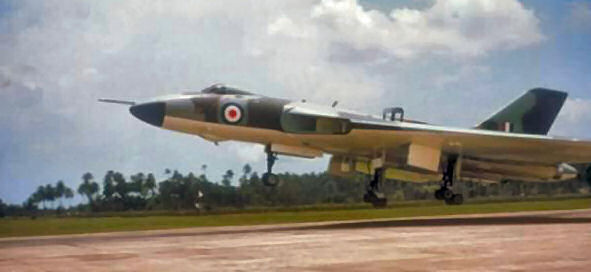 The RAF operated the Vulcan, which
was designed and built by the A.V. Roe aircraft company (AVRO), from
1956 until 1984. It was originally designed as a nuclear bomb
delivery vehicle but ended up doing all sorts of things.
The RAF operated the Vulcan, which
was designed and built by the A.V. Roe aircraft company (AVRO), from
1956 until 1984. It was originally designed as a nuclear bomb
delivery vehicle but ended up doing all sorts of things.